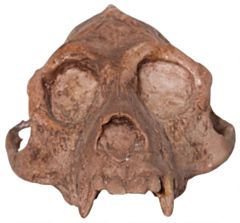Project 5071: A. Urciuoli, C. Zanolli, A. Beaudet, M. Pina, S. Almécija, S. Moyà-Solà , D. M. Alba. 2021. A comparative analysis of the vestibular apparatus in Epipliopithecus vindobonensis: Phylogenetic implications. Journal of Human Evolution. 151:102930.
Abstract
Pliopithecoids are an extinct group of catarrhine primates from the Miocene of Eurasia. More than 50 years ago, they were linked to hylobatids due to some morphological similarities, but most subsequent studies have supported a stem catarrhine status, due to the retention of multiple plesiomorphic features (e.g., the ectotympanic morphology) relative to crown catarrhines. More recently, some morphological similarities to hominoids have been noted, raising the question of whether they could be stem members of this clade. To re-evaluate these competing hypotheses, we examine the morphology of the semicircular canals of the bony labyrinth of the middle Miocene pliopithecid Epipliopithecus vindobonensis. The semicircular canals are suitable to test between these hypotheses because (1) they have been shown to embed strong phylogenetic signal and reliably discriminate among major clades; (2) several potential hominoid synapomorphies have been identified previously in the semicircular canals; and (3) semicircular canal morphology has not been previously described for any pliopithecoid. We use a deformation-based (landmark-free) three-dimensional geometric morphometric approach to compare Epipliopithecus with a broad primate sample of extant and extinct anthropoids. We quantify similarities in semicircular canal morphology using multivariate analyses, reconstruct ancestral morphotypes by means of a phylomorphospace approach, and identify catarrhine and hominoid synapomorphies based on discrete characters. Epipliopithecus semicircular canal morphology most closely resembles that of platyrrhines and Aegyptopithecus due to the retention of multiple anthropoid symplesiomorphies. However, Epipliopithecus is most parsimoniously interpreted as a stem catarrhine more derived than Aegyptopithecus due to the possession of a crown catarrhine synapomorphy (i.e., the rounded anterior canal), combined with the lack of other catarrhine and any hominoid synapomorphies. Some similarities with hylobatids and atelids are interpreted as homoplasies likely related to positional behavior. The semicircular canal morphology of Epipliopithecus thus supports the common view that pliopithecoids are stem catarrhines.Read the article »
Article DOI: 10.1016/j.jhevol.2020.102930
Project DOI: 10.7934/P5071, http://dx.doi.org/10.7934/P5071
| This project contains |
|---|
Download Project SDD File |
Currently Viewing:
MorphoBank Project 5071
MorphoBank Project 5071
- Creation Date:
26 January 2024 - Publication Date:
26 January 2024
This research
supported by
Authors' Institutions ![]()
- University of Bordeaux
- University of Manchester
- University of Pretoria
- University of the Witwatersrand
- American Museum of Natural History (AMNH)
- Universitat Autònoma de Barcelona
- New York Consortium in Evolutionary Primatology
- Institucio Catalana de Recerca i Estudis Avancats (ICREA)

